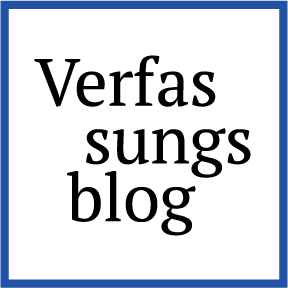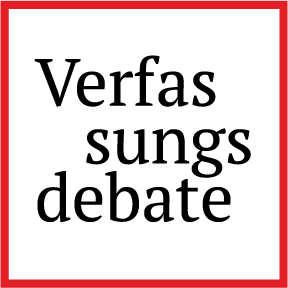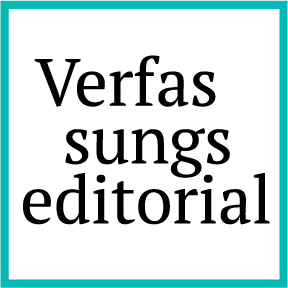How to Kill an Idea: An American’s Observations on the NPD Party-Ban Proceedings
On January 17 the Second Senate of the German Federal Constitutional Court will announce its decision on the federal states’ application seeking to ban the National Democratic Party of Germany (NPD).
It is not the purpose of this essay to detail the history, ideology, and political profile of the NPD. A number of English-language sources do that job well, including the reports collected at Spiegel Online’s English-language archive covering the NPD. It might be enough here to say that the NPD is widely viewed in Germany as an extreme right-wing or neo-Nazi political party that has enjoyed some electoral success at the state and local level, while also being linked to hate-motivated crimes and disruptive street protests. That is one portrayal. Another, perhaps more damning depiction, comes from Timur Vermes’ provocative best-seller Er is Wieder Da (2012). The novel tells the disturbing, satiric story of Hitler’s miraculous reappearance in Berlin in 2011 and his easy (re)ascendance to prominence in Germany. In Vermes’ story the revived Hitler has a chance to meet the NDP leadership in present-day Berlin. Rather than an ominous threat to the free democratic basic order, Hitler discovers a parodic and impotent gaggle of out-of-shape losers. Vermes’ description of the party’s headquarters makes the point: “The wretched little house stood shuddering in a gap between two apartment buildings like a child’s foot in his father’s slippers. The building alone looked hopeless and overwhelmed … ‘NPD Party Headquarters’ was scrawled above the door-bell in such small text that one would have to assume that it was the result of cowardice in the face of the party’s enemies.” To a large degree the party-ban proceeding will settle this question: Is the NPD a real and active threat to Germany democracy or is it a nasty, tasteless joke – but a joke nonetheless?
It is a momentous case, marking only the sixth such proceeding in the Court’s storied history. The application to ban the NPD comes to the Court under the terms of Article 21(2) of the Basic Law, which provides: “[p]arties that, by reason of their aims or the behavior of their adherents, seek to undermine or abolish the free democratic basic order or to endanger the existence of the Federal Republic of Germany shall be unconstitutional. The Federal Constitutional Court shall rule on the question of unconstitutionality.” Famously, in the immediate post-war years, the Court banned the Socialist Reich Party and the Communist Party of Germany, decisions that sought to distance West Germany from its National Socialist past and secure the country’s westward tilt in the framework of the deepening Cold War. Decades passed and a handful of applications met with failure, largely for technical reasons.
In recent memory the NPD has been the singular focus of this exceptional exercise of the state’s power to shape the political discourse. An application against the NPD “failed” in 2001, for example, when a three-justice minority of the Second Senate blocked efforts to continue with the proceedings after it was discovered that a not-insignificant number of the Party’s leaders were paid informants of state security agencies. The decisive justices concluded that it would have been impossible for the Court to distinguish between the Party’s authentic political agenda and an inflammatory platform that had been promoted and propped-up by the state itself as part of an attempt to ban the party. Three justices could block the case from going forward on the merits because the negative consequences of a party-ban procedure require a qualified, two-thirds majority of the Court.
More than a decade later the federal states returned to the Constitutional Court with the present application, alleging that the NPD “is a federal party, a national phenomenon, that functions as the axis, organizational-network, and the legal arm of an extreme right-wing political movement.” In a decision from December 2015 the Second Senate certified the case for three days of oral arguments to be held on March 1-3, 2016. I attended the hearing, which involved long days of strategic maneuvering, sparing over doctrine, and the presentation of facts. The following photo-essay provides some impressions from – and captures some of the spirit of – those intense, dramatic, and historic sessions.
*
The case files were carried into the Court’s hearing chamber on three wheeled carts suggesting that the Justices had large submissions from the parties and a massive evidentiary record with which to work. That alone might have justified the long time that elapsed from the filing of the application in 2013 to a decision on the merits, now four years later. But there were some difficulties along the way that slowed Court’s progress. The original reporting judge assigned to the case – Justice Michael Gerhardt – announced his early retirement from the Court after four months managing the case.

Assistants to the Court Bring the Case Files to the Hearing Chamber on the First Day of the Process
Justice Gerhardt’s successor as reporting judge was Justice Peter Müller, the former Minister President of the federal state Saarland. This political role, as well Justice Peter Huber’s prior service as Interior Minister for the federal state Thuringia, attracted objections from the NPD in the first stages of the oral hearing. The NPD moved to recuse them (and other justices who had been elected to the Court by the Federal Council of States) alleging bias.
The Court gave the NPD an extensive hearing on these objections and, unsurprisingly, rejected them with a summary order after the first lunch-break. At stake in this gambit, however, was not the actual recusal of the justices. Instead, it served to test the standards the Court would apply in what all agreed is an exercise of the most extreme form of the state’s power. Based on the handling of the NPD’s recusal motions it seemed that the Court, while earnest, was not resolved to apply the strictest of scrutiny to the rarest of all political sanctions.

The Constitutional Court’s Famous Accessibility and Transparency was Sacrificed to be Sure the Proceedings were Secure
Further delay in the proceedings resulted from the Court’s demand that the Bundesrat submit further briefing and evidence in support of its claim that it had comprehensively withdrawn or cut-off its embedded agents and informants. The support seems to have consisted in affidavits and declarations of state and federal domestic intelligence services and interior ministers. “Take our word for it,” they assured the Court, “we have disconnected and discontinued those sources.” It is one thing that the Court unquestioningly accepted these declarations. It is another that the Court, later in the proceeding, did not seem to distinguish between evidence gathered before the putative 2013 withdrawal and evidence developed after that date.
*
Stanislaw Tillich, the Minister President of Saxony, was the President of the Federal Council of States (Bundesrat) at the time of the hearing. Speaking for all of Germany’s federal states, the Bundesrat claimed to have a particular appreciation for the threat posed by the NPD at the level of state and local politics. His opening remarks were damning and sharp: “The NPD is a racist, anti-Semitic, revisionist, and anti-democratic party. Its ideology is undeniably aligned with the tradition of the historical National Socialism.”
![Minister President Tillich [center]](https://verfassungsblog.de/wp-content/uploads/2017/01/Tillich-1024x768.jpg)
Minister President Tillich [center]
But the Bundesrat’s role in spearheading the application underscored the fact that the NPD has its greatest impact in just a couple of the new (formerly East German) federal states, with Saxony and Mecklenburg-Vorpommern being the leading cases. If it is necessary that a party have national significance and pose a threat to the federal order, then it will be hard to say that the NPD qualifies.
*
![Renate Künast [left], Green Party Parliamentarian](https://verfassungsblog.de/wp-content/uploads/2017/01/Künast-1024x768.jpg)
Renate Künast [left], Green Party Parliamentarian
Even for a Court accustomed to high political drama, the proceedings were exceptional as they attracted political luminaries, such as former Federal Minister and Green Party politician Renate Künast. She attended in her capacity as Chairwoman of the Federal Parliament’s Committee on Legal Affairs and Consumer Protection. But the large number of political figures present at the hearing in support of the proposed ban was the more impactful signal. The minister presidents of three states attended (including Tillich). Twelve of sixteen state interior ministers attended. Nine members of the federal parliament (including Künast) were present at the hearing.

Media Screens in the Karlsruhe Central Train Station Carried News of the Proceedings
An unavoidable and inherent feature of a party-ban is that it allows the “constitutionally acceptable” parties to shape the political discourse and to manage electoral dynamics in ways that advantage and prioritize their values and platforms. But the cause is so righteous that these discomfiting truths weren’t given anything but passing attention during the proceedings. Yet, the world is learning – from Brexit to Trump to Le Pen – that there is also a risk in such elite-driven efforts to dictate “decent” or “acceptable” politics from above.
*

As a court of first-instance in the case the Second Senate had to reach out to criminal procedure as a guide for the applicable standards of proof and rules for taking evidence. Most of the evidence was presented as attachments to the pleadings. But a number of fact witnesses did appear at the hearing, including representatives of the domestic intelligence services and representatives of the party. All of this proceeded with a degree of informality that was unfamiliar to (and discomfiting for) a lawyer trained in the common law’s adversarial tradition.
*
Peter Richter represented the NPD throughout the party-ban proceedings. The convinced right-wing lawyer and active member of the party has been portrayed by the media as a Wunderkind, not the least because he recorded his home state’s highest scores when sitting for the first and second state bar exams. His performance before the Court did not live up to that account. He made many obvious strategic mistakes and devoted much of his time at the podium to merely reading aloud – often at length – from the written submissions. One significant strategic mistake was Richter’s insistence on treating the case as an assault on the NPD and its grotesque beliefs as opposed to an assault on marginal and minority viewpoints more generally. Instead of a defense of the NPD’s xenophobic ideas about biological citizenship, Richter should have insisted that in this forum and in this posture the NPD was seeking to defend the rights of all Germans to a free and self-determining political culture.
![Peter Richter [left] and NPD Supporters](https://verfassungsblog.de/wp-content/uploads/2017/01/Peter-Richter-1024x768.jpg)
Peter Richter [left] and NPD Supporters
I worried that, by insisting on Richter’s brilliance, the media was both stoking the drama of the event and lending credibility to the proceeding should the Court ultimately choose to ban the party. The sentiment might run: A party-ban is an extreme measure, to be sure, but at least the NPD was ably represented at the Court. No one who attended the hearing, however, could be reassured that the ban would be meted-out following a struggle of equally capable jurists.
*

German Constitutional Court’s Hearing Chamber Seats Reserved for Security
The conflicting values implicated by the party-ban proceeding were in sharp relief at the Court, which is a beloved symbol of Germany’s democratic renewal and a vigorous defender of individual freedoms. But in this context the Court might be viewed as an instrument of conservative forces, including the country’s many domestic security services known as the Offices for the Protection of the Constitution. These state and federal institutions are charged with developing the intelligence needed to ensure respect for Germany’s hard-won “free democratic basic order.” They are largely responsible for accumulating and interpreting the evidence upon which the federal states based their party-ban application. Yet, in the proceedings’ early phase, they were challenged to demonstrate that they had effectively withdrawn their support for informants embedded in the party so as to avoid the problems that ultimately doomed the 2001 case. The ease with which the Court accepted this claim, which was largely substantiated by written declarations offered by the heads of these agencies, did the Court no great credit. And it conflicted with the broader distrust Germans seem to have for intelligence services and their missions.
![Hans-Georg Maaßen [center], President of the Federal Office for the Protection of the Constitution](https://verfassungsblog.de/wp-content/uploads/2017/01/Maaßen-1024x768.jpg)
Hans-Georg Maaßen [center], President of the Federal Office for the Protection of the Constitution
*
Frank Franz, the NPD’s Party Chairman, seems to want embody a modern look for a party long associated with skinheads and black leather. He could be mistaken for a sharply-dressed thirty-something businessman of a type seen anywhere in Germany. Not even his extraordinarily upright posture would distinguish him. Maybe he hopes to steer the party towards a more mainstream brand of populism, as Marine Le Pen has managed to do for the National Front in France.
![Franz [back to camera] Addresses Media in the Court’s Hearing Chamber](https://verfassungsblog.de/wp-content/uploads/2017/01/Franz-Gerichtssaal-1024x768.jpg)
Franz [back to camera] Addresses Media in the Court’s Hearing Chamber
That effort at moderation stumbled at the Court however, where Franz’s attempt to rationalize and rehabilitate the party’s positions on “ethnic citizenship” and the “Volksgemeinschaft” (national community) were easily shredded by the justices’ probing questions. Franz sought to obscure the party’s evident racism behind a focus on the unique place of German citizens in the national polity, and denying non-citizens the same spectrum of rights. But, as the justices repeatedly noted, the party’s theory assumes a homogenous – and Aryan – German citizenry that is (willfully) ignorant about Germany’s liberalized immigration regime and that does not reflect the reality of a diverse Germany. Significantly, these views never were a fair and faithful portrayal of German life. As Justice Maidowski insisted: “your program won’t work because citizenship law now makes some non-Aryans ‘Germans’ along with their children.”
![Franz [foreground] in the Court’s Foyer](https://verfassungsblog.de/wp-content/uploads/2017/01/Franz-Foyer-1024x768.jpg)
Franz [foreground] in the Court’s Foyer
But even Franz’s ineffectual parrying with the much nimbler justices exposed a uniquely problematic feature of the party-ban process. Must – or should – a political party have to account to the state for its political ideas? As with the lawyer Richter’s poorly conceived strategy, Franz would have done much better to refuse to answer questions about the party’s ideology while pointing to the Basic Law’s protection of freedom of opinion. That guarantee, Franz might have insisted, draws particular meaning from the terrible period during which the German state was busy scrutinizing the beliefs of its citizens.
*

Second Senate takes the Bench Moments before Cameras are Excluded from the Courtroom
In calling the case to order – and before handing the proceedings over to the reporting judge (Justice Müller) – Court President Andreas Voßkuhle conceded that a party-ban is a “sharp and two-sided sword.” Created to protect democracy from those who might abuse it, President Voßkuhle warned that it could also involve some deploying their freedoms to remove from the public discourse those with different ideas. “It must be implemented with caution,” President Voßkuhle insisted, because “it restricts freedom in order to preserve freedom.”
*
Humboldt University law professor Christoph Möllers represented the Bundesrat in the proceedings. Almost the perfect opposite of the NPD’s representative, Möllers exuded charisma, competence, and confidence. His frequent appearances before the Court surely aided him in his performance, which at times seemed like a casual conversation between him and the justices.
![Prof. Christoph Möllers [right] Represented the Bundesrat before the Court](https://verfassungsblog.de/wp-content/uploads/2017/01/Möllers-1024x768.jpg)
Prof. Christoph Möllers [right] Represented the Bundesrat before the Court
Still, Möllers had to account for his clear expression of skepticism toward party-bans in his book Demokratie: Zumutungen und Versprechungen (2008). There was no chance the conflict between those claims and his advocacy for a ban would become decisive to the case. But Möllers’ answer to the challenge landed flat. He conceded that the ban represented a failure of discursive politics. “But sometimes – as in the case of racism – we should quit politics,” he explained. His willingness to tolerate the NPD’s politics had been eroded, he noted, by hearing first hand from friends and colleagues in former East German regions where the NPD enjoys some strength.
When pressed by the justices to clarify his view on the standard they should apply, Möllers advanced a preemptive approach, arguing that it might be necessary to ban a party even at a point when they appear incapable of succeeding with a platform aimed at undermining the free democratic basic order. Nodding to both the NPD’s racism and the sudden surge of refugees that had flooded into Germany in the months prior to the hearing, Möllers urged that a more flexible standard was necessary. “Think about how fast things change,” he argued.
*
As Germany – and the rest of the world, looking on with some curiosity – prepares to learn the fate of the NPD, careful reflection on Germany’s implementation of the party-ban process is well justified. The proceedings are historic and jurisprudentially absorbing. But, as concern about populist movements’ democratic success mounts across the West, we must reflect on whether such a measure is a solution, and if so, how it should be meted out. Would it have been better to preclude a debate about Brexit altogether, allowing those sentiments to stew in English politics and civic life? Wide-ranging and bi-partisan efforts to marginalize and exclude Trumpism during the American presidential campaign backfired spectacularly. How firm is our commitment to open political discourse? What is the limit of democratic tolerance? These are the issues at the heart of the NDP party-ban proceeding and, increasingly, at the core of our democratic life. We will soon have Karlsruhe’s answer to these questions.
Fotos: Russell A. Miller, All Rights Reserved




In The Netherlands, the prosecutors petitioned the court to have the Paedophile Party banned.
(Which can be done using the same procedure as for any other legal person whose objectives or activities are contrary to public order or morals, on petition by the prosecutor’s office in the normal court of first instance.)
This struck me as clearly wrong. Not only because the “party” literally had less than a dozen supporters, but also because in a case like that the freedom of speech and of assembly should have prevailed. But banning a party that tries to use its constitutional freedoms in order to abolish the constitutional freedoms of others makes a certain conceptual sense. I’m not sure that I’d support it, but I don’t strongly oppose it either.
@Holterman A case like that would have gone to the administrative courts in Germany, I suppose. A “party” with a dozen supporters is not a party in the sense of Art. 21 GG. We had a Neonazi “party” called Freiheitliche Deutsche Arbeiterpartei (FAP) which was deemed too insignificant to enjoy the privileges of a party in the first place and therefore could be and was banned by administrative order in 1995.
An “outsider’s” perspective – in the sense of somebody who has intimate knowledge of, but is not part of Germany – is certainly an interesting read. Thanks for this article.
One may have doubt that the Bundesrat’s attempt to have the NPD banned will be successful or that it is even tactially a smart move. It may cause right-wing politicians to go underground, and the rise of the AfD may have made the NPD and their possible ban obsolete anyhow.
One has to keep in mind, though, that the attempt may have worth by itself, even if futile. At least, it will serve as a reminder that the majority does not condone radicalism, and despite all their differences, the other parties can at least agree on not liking Nazis.
Dear Russell,
Thanks a lot for your insight and your reflective thoughts from an outsider’s perspective! They are worth reading a lot.
I would like to add a few thoughts:
What if the German dedication to a free discourse is or was not that intense and firm to begin with? Especially if you understand “free” as extreme, there are notable differences between what the US 1st Amendment protects and what German law deems legal. In the last 50 years, the most extreme of opions were never really in the scope of judicial protection for the BVerfG. (To sharpen the thought: “After all, what are we missing out on?”) Therefore it is only coherent and probably quite logical that Richter did not make the free speech argument. This argumet would have probably persuaded an American court, but not a German one. In my opinion the main reason is: The whole exceptionalism (cf. Schauer, The Exceptional First Amendment) and breathing space (NAACP v. Button) argument is unknown under Art. 5 GG.
That Richter did rather try to lawyer the case for the bogus idea of a “Volksgemeinschaft”, is obviously doomed to failure. But probably it seemed to him the more promising way: Going down with flying colours. In addition, this is the only thing to argue that is coherent with his world view: If you are against the German constitutional order, you cannot make your case based for freedom of expression. In conclusion, a shot in the foot, but still, somewhat coherent, or?
Regarding your remark that it was “proceeded with a degree of informality that was unfamiliar to (and discomfiting for) a lawyer trained in the common law’s adversarial tradition”, I am keen to know more. What struck you as discomforting? How did it differ from the ordinary German court proceedings when it comes to evidence? (My fear would be: It does not differ by much.)
I am also wondering, what kind of evidenve you would have requested from German secret services to ensure they have severed their ties?